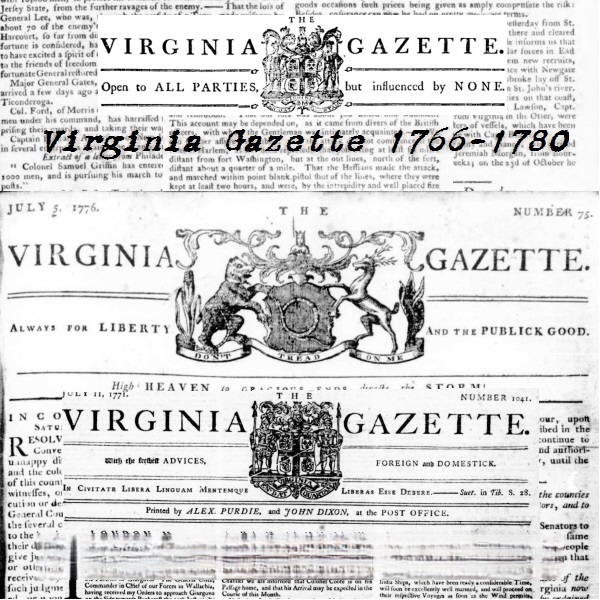
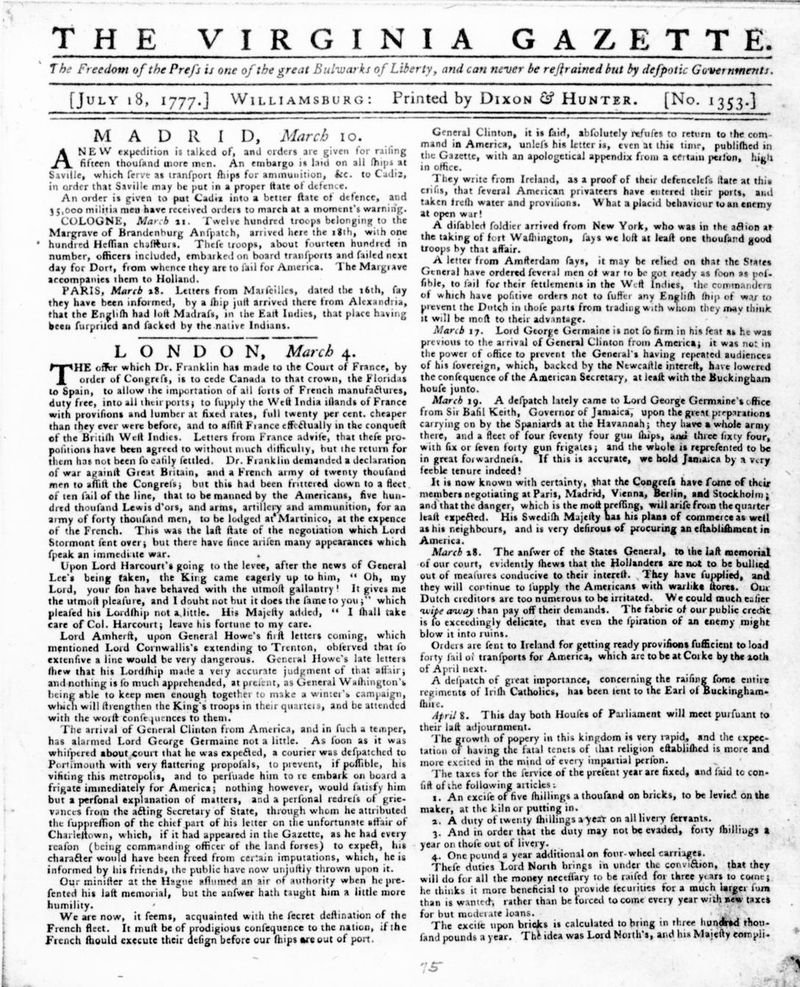
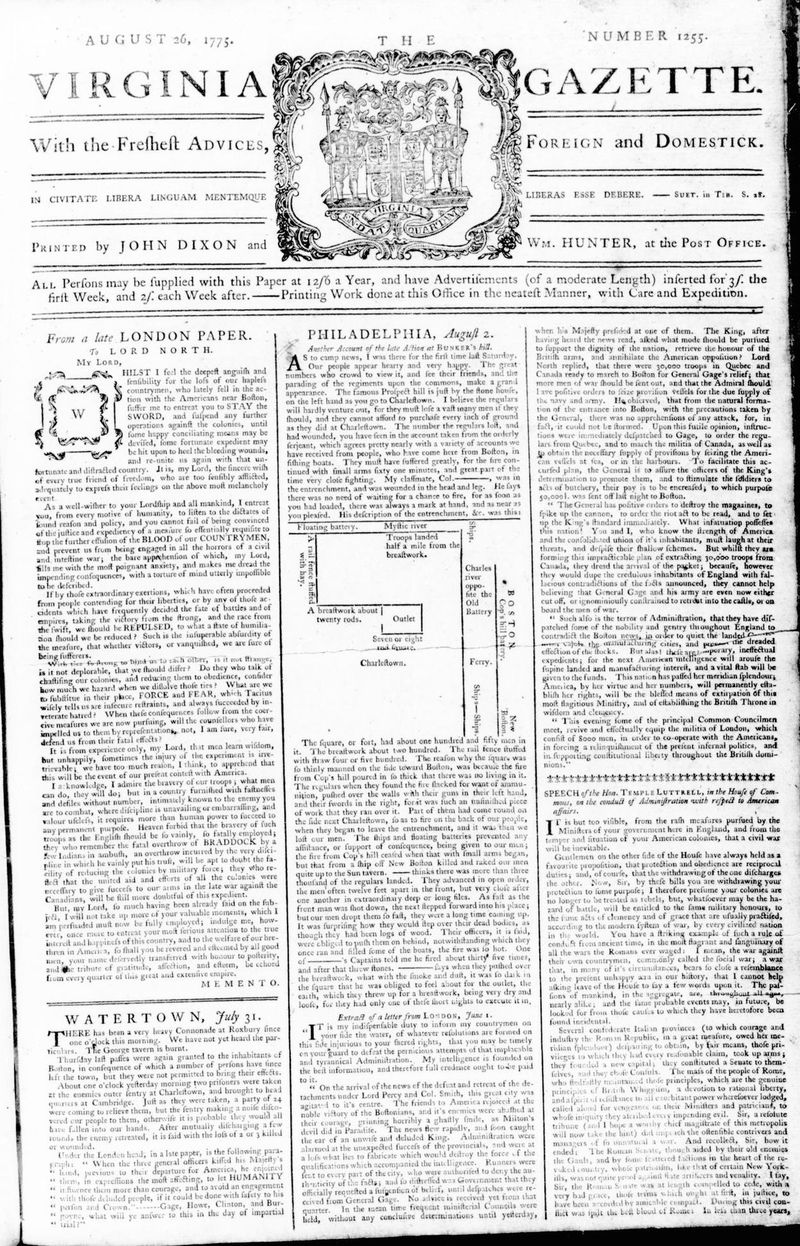
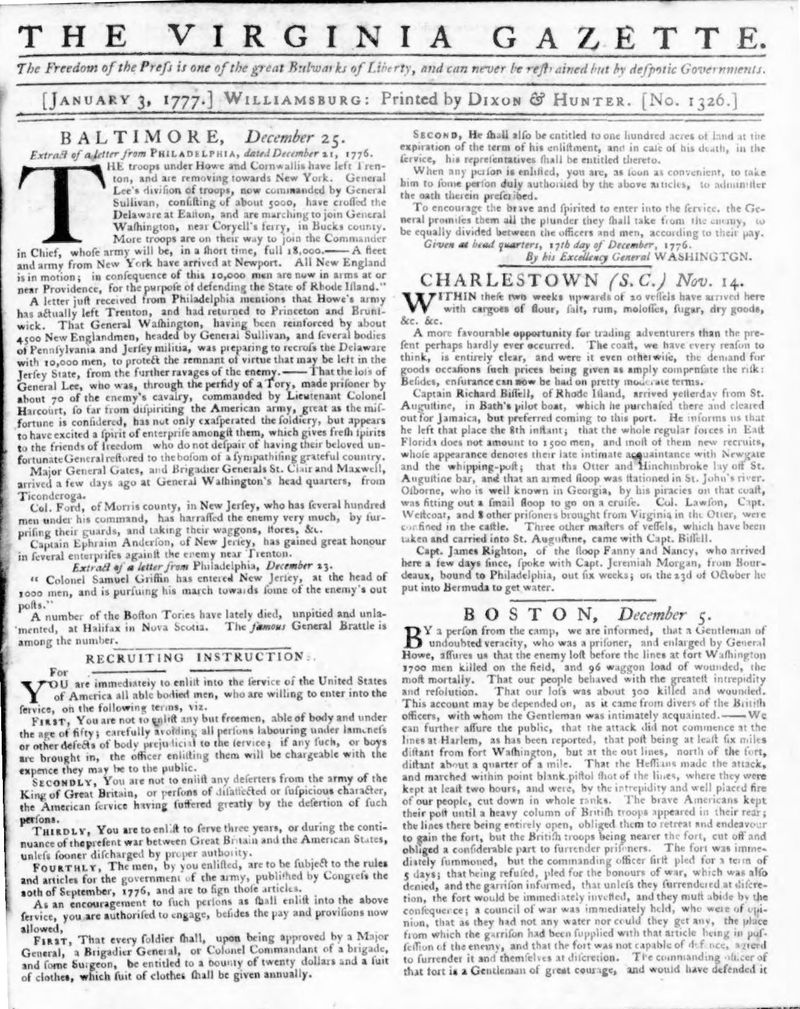
Description
Virginia Gazettes and the American Revolution, 1766-1777
Timeline of Main Events (1766-1777)
- 1766:
- The repeal of the Stamp Act is met with “general illuminations” and celebrations in Virginia, as reported by the Virginia Gazette. The prevailing sentiment is that differences between Britain and the colonies are “happily terminated.”
- William Rind establishes the second Virginia Gazette, reportedly at the urging of Thomas Jefferson who desired a more critical voice against public officials than the existing Gazette.
- Alexander Purdie and John Dixon begin co-publishing the first Virginia Gazette.
- September 14, 1769:
- An advertisement placed by Thomas Jefferson appears in the Purdie & Dixon Virginia Gazette offering a reward for the return of his runaway slave, Sandy.
- January 29, 1773:
- Thomas Jefferson sells his returned slave, Sandy, to Col. Charles Lewis.
- 1773:
- William Rind, publisher of the second Virginia Gazette, dies. His widow, Clementina Rind, takes over publication.
- 1774:
- Clementina Rind ceases publishing the second Virginia Gazette. John Pinkney becomes the new publisher.
- February 3, 1775:
- The third Virginia Gazette is first published by Alexander Purdie, who had previously co-published the original Gazette.
- The last issue of the second Virginia Gazette, published by John Pinkney, is printed.
- April 20, 1775:
- The Gunpowder Incident: Lord Dunmore, the Royal Governor of Virginia, orders the removal of gunpowder from the Williamsburg magazine to a Royal Navy ship, sparking unrest.
- April 22, 1775:
- The Virginia Gazette (Dixon & Hunter) reports on the Gunpowder Incident and the subsequent militia mobilization led by Patrick Henry. The issue is resolved peacefully with a payment to Henry.
- May 15, 1776:
- Virginia’s revolutionary convention unanimously adopts a resolution instructing its delegates in Congress to propose a motion for independence from Great Britain, making Virginia the first colony to do so.
- June 12, 1776:
- Virginia’s revolutionary convention adopts the Declaration of Rights.
- June 29, 1776:
- Virginia’s revolutionary convention adopts a constitution for the new Commonwealth of Virginia.
- June 30, 1776:
- Patrick Henry is sworn in as the first governor of the Commonwealth of Virginia.
- July 5, 1776:
- The Virginia Gazette (Purdie) reports on Virginia’s declaration of independence, noting the resolution passed by the revolutionary convention.
- July 12, 1776:
- Alexander Purdie’s Virginia Gazette publishes the first reference to the Declaration of Independence.
- July 19, 1776:
- Purdie’s Virginia Gazette prints passages from the Declaration of Independence.
- July 26, 1776:
- Alexander Purdie’s Virginia Gazette becomes the first American newspaper to publish the complete full text of the United States Declaration of Independence.
- August 26, 1775:
- The Virginia Gazette (Dixon & Hunter) features an eyewitness account and an illustration of the Battle of Bunker Hill.
- January 3, 1777:
- The Virginia Gazette (Dixon & Hunter) publishes General George Washington’s recruiting instructions, offering land and plunder to those who enlist.
- July 18, 1777:
- The Virginia Gazette (Dixon & Hunter) features front-page news of Benjamin Franklin appearing at the Court of King Louis XVI to seek French declaration of war against Britain.
Cast of Characters with Brief Bios:
- John Adams (1735-1826): An American statesman, lawyer, diplomat, and Founding Father who served as the second president of the United States (1797–1801). His 1818 letter to Hezekiah Niles highlights the crucial role of newspapers in shaping public opinion during the Revolution.
- Todd Andrlik: Author of “Reporting the Revolutionary War.” His insights emphasize the value of Revolutionary War-era newspapers in understanding the period from the perspective of figures like George Washington.
- Lord Dunmore (John Murray, 4th Earl of Dunmore) (1730-1809): The Royal Governor of the Colony of Virginia during the early stages of the American Revolution. His order to remove gunpowder from Williamsburg in April 1775 (the Gunpowder Incident) escalated tensions.
- Benjamin Franklin (1706-1790): An American polymath and one of the Founding Fathers of the United States. In 1777, he was actively seeking foreign support for the American cause, including a declaration of war from France against Britain.
- Patrick Henry (1736-1799): An American attorney, planter, and orator known for his fiery rhetoric during the American Revolution, particularly his “Give me liberty, or give me death!” speech. He led the militia response to the Gunpowder Incident and became the first governor of the Commonwealth of Virginia.
- William Hunter (c. 1720-1761): Publisher of the first Virginia Gazette from 1751 to 1761. Later, his name appeared in the publishing partnership of Dixon & Hunter (1775-1778) for one of the Virginia Gazettes.
- Thomas Jefferson (1743-1826): An American statesman, principal author of the Declaration of Independence, and the third president of the United States. He reportedly encouraged the establishment of a second Virginia Gazette for more critical reporting. He also placed an advertisement in the Virginia Gazette for his runaway slave, Sandy.
- Col. Charles Lewis (Date of birth and death unknown): Purchased the slave Sandy from Thomas Jefferson in 1773.
- Thomas Nicolson (Dates of birth and death unknown): Partner in the publication of the first Virginia Gazette with John Dixon from 1779 to 1780 (Dixon & Nicolson).
- Hezekiah Niles (1777-1839): An American newspaper editor and publisher to whom John Adams wrote a letter in 1818 discussing the impact of newspapers on the American Revolution.
- Thomas Paine (1737-1809): An English-born American political activist, philosopher, political theorist, and revolutionary. Excerpts from his influential pamphlet “Common Sense” were published in Alexander Purdie’s Virginia Gazette.
- William Parks (c. 1699-1750): The founder and first publisher of the Virginia Gazette, beginning in 1736. His paper was the first ever published in Virginia.
- John Pinkney (Dates of birth and death unknown): The final publisher of the second Virginia Gazette, from 1774 until its last issue in February 1776.
- Alexander Purdie (c. 1743-1779): A significant figure in Virginia journalism during the Revolution. He co-published the first Virginia Gazette (Purdie & Dixon), then established and published the third Virginia Gazette, which strongly supported independence and was the first to publish the full Declaration of Independence.
- Clementina Rind (Dates of birth and death unknown): Widow of William Rind who continued publishing the second Virginia Gazette after his death until 1774.
- William Rind (c. 1733-1773): Founder and publisher of the second Virginia Gazette in 1766. His paper was intended to provide a more critical perspective on public affairs.
- Joseph Royle (c. 1732-1766): Publisher of the first Virginia Gazette from 1761 to 1765.
- Isaiah Thomas (1749-1831): An American newspaper publisher and author of “History of Printing in America,” in which he quoted Thomas Jefferson’s reasons for supporting the establishment of a second Virginia Gazette.
- George Washington (1732-1799): Commander-in-Chief of the Continental Army during the American Revolutionary War and the first president of the United States. His recruiting instructions were published in the Virginia Gazette.
- John Clarkson and Augustine Davis: Publishers of the third Virginia Gazette from 1779 to its end in December 1780, following the death of Alexander Purdie.
- John Dixon: Co-publisher of the first Virginia Gazette with Alexander Purdie (1766-1775), then with William Hunter (1775-1778), and finally with Thomas Nicolson (1779-1780).
American Revolution Newspapers: Virginia Gazette 1766 to 1780
6,600 pages, composed of 5,200 newspaper pages, plus 1,400 pages of indexing of three different newspapers all called the “Virginia Gazette,” published from 1766 to 1788.
Entire copies of approximately 1,300 weekly issues, all extant copies of the Virginia Gazette 1, 2 and 3, dating from 1766 to 1780, available to the Virginia State Library at the time it assembled this collection.
This collection is a valuable tool for following the American Revolution. Newspapers played a vital role in the American Revolution. They were the only form of mass media in the 18th Century.
John Adams in a letter dated 13 February 1818, to newspaper editor Hezekiah Niles, who was born in 1777, remarked that the major achievement of the Revolution was the radical change in the principles, opinions, sentiments, and affections of the people away from Britain and toward independence. A move he saw as being nurtured by the fourth estate. Adams wrote that to investigate how this happened, “it is greatly to be desired that young gentlemen of letters in all the States, especially in the thirteen original States, would undertake the laborious but certainly interesting and amusing task of searching and collecting all the records, pamphlets, newspapers, and even handbills, which in any way contributed to change the temper and views of the people and compose them into an independent nation.”
According to Todd Andrlik, author of the book, “Reporting the Revolutionary War,” “What I love most about American Revolution-era newspapers is that they let you see the world as George Washington saw it. When I’m reading about the Battle of Bunker Hill in a Virginia Gazette, I feel like I’m looking over Washington’s shoulders. It is also worth noting that our founding fathers were the first collectors of newspapers because they realized the value of their historical record. ‘I consider their preservation as a duty,’ Thomas Jefferson said.”
The issues of Virginia Gazettes show America transforming from a British colony into an independent nation. In 1766, the Gazette was careful in its rejoicing the appeal of the Stamp Act, writing, “On Friday last, a good deal of Company being in Town at the Oyer and Terminer Court, our Gratitude and Thankfulness upon the joyful Occasion of the Repeal of the Stamp Act and the universal Pleasure and Satisfaction it gives that all Differences between the Mother Country and her Colonies are so happily terminated, was manifested here by general illuminations…” Ten years later the Declaration of Independence was being published in its entirety.
Between 1736 and 1780, Williamsburg, Virginia was home to three newspapers with the name Virginia Gazette. At times two or three Gazettes were published at the same time.
The first Virginia Gazette, first issue August 6, 1736, was the first newspaper ever published in Virginia. Its publisher William Parks used the motto on its front cover, “Containing the freshest Advices, Foreign and Domestick.” Parks published the Gazette until 1850. The paper was then published by William Hunter (1751–1761), Joseph Royle (1761–1765), Alexander Purdie and John Dixon (1766-1775), Dixon and Hunter (1775-1778), and Dixon and Thomas Nicolson (1779–1780).
The second Virginia Gazette was founded by William Rind in 1766. Rind published the second Gazette until his death in 1773. The paper was then published by his widow Clementina Rind (1773-1774), and finally by John Pinkney (1774-1776). Its last issue was printed on February 3, 1776.
William Rind was urged to start the second Gazette by Thomas Jefferson. Jefferson was upset that the original Gazette was slow to criticize public officials or address controversies. Isaiah Thomas (January 30, 1749 – April 4, 1831) the American newspaper publisher, in his book “History of Printing in America,” published in 1810, quoted Jefferson as saying, “we had but one press, and that having the whole business of the government, and no competitor for public favor, nothing disagreeable to the governor could be got into it. We procured Rind to come from Maryland to publish a free paper.”
The third Virginia Gazette was first published on February 3, 1775. Its publisher was Alexander Purdie, who had previously co-published the original Gazette from 1766 to 1775. It was published by Purdie until his death in 1779; it was then published by John Clarkson and Augustine Davis until December 9, 1780.
Alexander Purdie was the publisher who most embraced independence and thrived during the American Revolution. Purdie published excerpts from Thomas Paine’s “Common Sense,” and published the first reference to the Declaration of Independence on July 12, 1776. The next week he printed passages from the document on July 19, 1776. Purdie’s Virginia Gazette was the first American newspaper to publish the complete full text of the United States Declaration of Independence, which was printed on July 26, 1776.
Purdie changed the front page of his Gazette several times to reflect his solidarity for the cause of independence from Britain. At first the masthead read, “Thirteen United Colonies” and “United we stand, divided we fall.” Later, an image of a coiled snake was on the masthead with the motto “Don’t tread on me.” It was subtitled “High Heaven to Gracious Ends directs the Storm!”
In this collection the variants of the Gazette are divided by the publisher or publishers of the three distinct newspapers, Alexander Purdie, Purdie and John Dixon, Dixon and William Hunter, Dixon and Thomas Nicolson, William Rind, Clemintina Rind, John Pinkney, and John Clarkson and Augustine Davis.
Covering the years:
1766-1774 Purdie and Dixon
1766-1774 Rind
1774-1776 Pinkney
1775-1778 Dixon & Hunter
1775-1778 Purdie
1779-1780 Clarkson and Davis
1779-1780 Dixon & Nicolson
Coverage of the independence movement is printed alongside the issues and events of the period. Standing in paradox to the quest for freedom by the colonists reported in the pages of the Gazettes are ads offering rewards for the return of runaway slaves and ads for the sale of enslaved persons.
In the Purdie & Dixon September 14, 1769 Gazette appears a runaway slave ad inserted by Thomas Jefferson. In the advertisement Thomas Jefferson, who had inherited half of his father Peter’s more than sixty slaves, offered a forty shilling reward for the return of “a Mulatto slave called Sandy.” After Sandy’s return, Jefferson sold him, to Col. Charles Lewis for 100 pounds on January 29, 1773.
Items of interest among the thousands of articles:
Virginia Gazette – Dixon & Hunter – April 22, 1775
The Gazette reports on The Gunpowder Incident also known as the Gunpowder Affair.
An early conflict in the American Revolutionary War between Lord Dunmore, the Royal Governor of the Colony of Virginia, and a militia led by Patrick Henry. On April 20, 1775, one day after the Battles of Lexington and Concord, before news of those events had reached Virginia; Lord Dunmore ordered the removal of the gunpowder from a storage magazine in Williamsburg, Virginia, to a Royal Navy ship. This action sparked local unrest, and militia companies began mustering throughout the colony. Patrick Henry led a small militia force toward Williamsburg to force the return of the gunpowder to the colony’s control. The matter was resolved without gunfire when a payment of £330 was made to Henry. Dunmore, fearing for his personal safety, later retreated to a British naval vessel, ending royal control of the Virginia colony.

Virginia Gazette – Dixon & Hunter – August 26, 1775 – Eyewitness account of the Battle of Bunker Hill.
This issue of the Virginia Gazette features an eyewitness account of the Battle of Bunker Hill. “And alongside that account is an engraving, or an illustration I should say, of the entrenchment on Breed’s Hill [where most of the battle was actually fought],” author Todd Andrlik says. “This is one of a kind … in the sense that this is the only known newspaper illustration to depict a current event during the entire American Revolution.”

Virginia Gazette – Purdie – July 5, 1776 Virginia declares indepence from Britain
The 5 July 1776 edition of the Virginia Gazette reported the conclusion reached by the delegates to the last of Virginia’s revolutionary conventions: that it was “indispensably necessary to establish government in this colony, independent of the crown of Great Britain.” After two days of sharp debate in Williamsburg, the members of the convention had unanimously adopted a resolution on 15 May instructing the colony’s delegates in Congress to introduce a motion for independence, becoming the first American colony to do so. Later the revolutionary convention subsequently adopted the Declaration of Rights on June 12 and a constitution for the new commonwealth on June 29. The following day, Patrick Henry was sworn in as governor of the Commonwealth of Virginia.

Virginia Gazette – Dixon & Hunter – January 3, 1777 – General George Washington’s recruiting instructions
Alongside news of the rebellion, General George Washington’s recruiting instructions. Washington says after discharge, soldiers were to receive 100 acres of land and “all the plunder they shall take from the enemy.”

Virginia Gazette – Dixon & Hunter – July 18, 1777 Benjamin Franklin seeks to have France declare war on England
Front page news of Benjamin Franklin’s appearance at the Court of King Louis XVI, seeking to have France declare war on Britain.

Related products
-
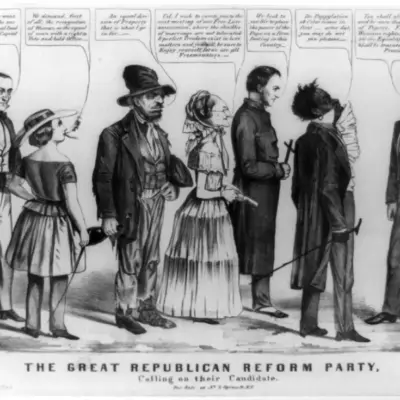

Slavery Political Cartoons: Cartoon Slavery 1789 – 1880
$19.50 Add to Cart -
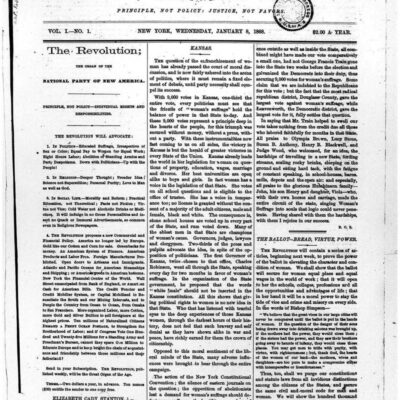
The Revolution Susan B Anthony Suffrage/Women’s Rights
$19.50 Add to Cart -
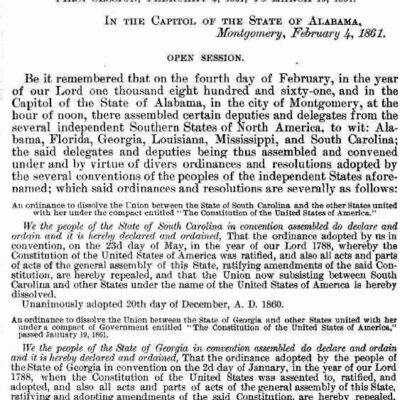
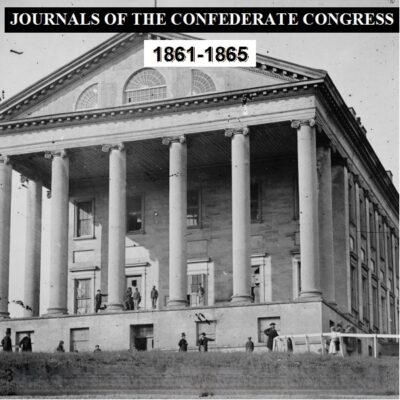
Journal of the Congress of the Confederate States of America 1861-1865
$19.50 Add to Cart -
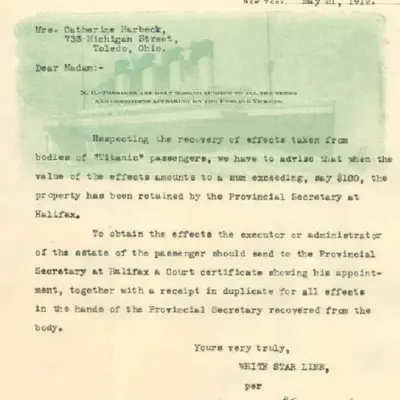
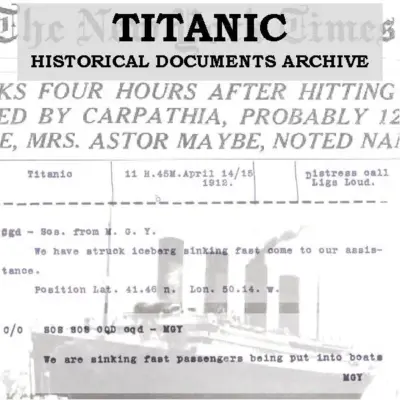
Titanic Disaster Historical Documents Archive
$29.90 Add to Cart